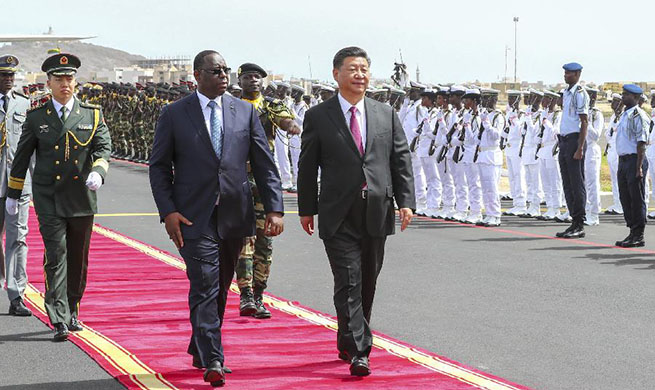by Xinhua writer Yu Fei
BEIJING, July 22 (Xinhua) -- Chang Jin, chief scientist of China's Dark Matter Particle Explorer (DAMPE), nicknamed "Wukong" or "Monkey King", often finishes his meal quite quickly, a habit formed due to hunger in childhood.
While U.S. scientists were observing the rotation of galaxies in 1970s and beginning to understand the existence of invisible, mysterious dark matter, Chang was a pupil in a poor village in Taixing County, east China's Jiangsu Province.
He had three brothers, and the one who ate slowest would stay hungry.
Hunger not only left him the habit of eating fast, but also cultivated his character of pursuing efficiency in work.
Even after Chang became the chief scientist of DAMPE in 2011, his parents only earned about 20,000 yuan (about 3,000 U.S. dollars) a year in the rural area.
"In my father's last days, he worried that if our satellite failed, the money wasted would be equivalent to the total income of tens of thousands of families in our hometown," said Chang. "That's why I work with extreme caution. We must succeed. We cannot waste the state's research money."
When Chang graduated from the University of Science and Technology of China and started work at the space astronomy lab in the Purple Mountain Observatory in Nanjing, capital of Jiangsu Province, in 1992, he was surprised to find that Chinese space astronomy was a blank sheet.
"I felt like I was working in a car factory where no car had been produced," Chang recalled.
All he could do was sitting in the library and earnestly reading all the books and papers about the astronomical satellites of other countries.
At that time, China launched its manned space program. Chang followed his tutor to develop an instrument that was later installed on the Shenzhou-2 spacecraft and obtained a large amount of observation data on solar flares and gamma-ray bursts.
This was China's first astronomical observation in space in its real sense and laid the foundation for the development of space astronomy in China.
The project made Chang aware of the huge gap between China and the world's advanced level in space astronomy. But the detection of high-energy cosmic electrons and gamma-rays had still not been accomplished. If China could devise the detection method, breakthroughs might be achieved.
The observations of the Hubble space telescope in 1998 overturned understanding of the universe: the expansion of the universe is speeding up, which scientists believe is caused by "dark energy." All the things that scientists have been trying to comprehend account for a tiny 5 percent of the universe, and dark matter and dark energy make up the rest.
That same year, Chang made a breakthrough in the detection of high-energy electrons and gamma-rays. It was previously believed that only expensive, heavy detectors could be used, but Chang invented an observation method with cheaper, thinner and lighter instruments.
This was when U.S. scientists were planning to observe cosmic rays by releasing a balloon-borne instrument over Antarctica. Chang found that instrument could also be used to detect high-energy electrons and gamma-rays. The U.S. scientists thought that was crazy.
To persuade them to include his observation method, Chang flew to the United States. The U.S. scientists asked him to calculate all the parameters in their computer. Chang, having no laptop, had to convert his idea into computer programs and calculate and check all the parameters. He had no sleep for 36 consecutive hours.
At last, the U.S. scientists were convinced and agreed to share their observation data with Chang for analysis. One of the most important articles of the program was later published in Nature, with Chang as the first author.
In the research, Chang found an unexpected surplus of high-energy electrons which might be caused by the annihilation of dark matter. Had he glimpsed the "ghost" of the universe? The balloon experiment could not exclude interference from other celestial bodies and "noises" in the atmosphere. A space probe was necessary for clearer observation.
In 2011, China inaugurated a program to develop a series of scientific satellites including DAMPE.
Chang's novel detection technology and method were implemented in the DAMPE satellite, which cost just a seventh of NASA's Fermi Space Telescope and a twentieth of the Alpha Magnetic Spectrometer (AMS-02), a state-of-the-art particle physics detector operating on the International Space Station (ISS).
Hundreds of scientists took part in the development of DAMPE. One of the greatest challenges was to improve the satellite's particle identification ability, which could be compared to precisely picking out 20 people in a city with a population of 20 million.
Another challenge was to extend the detector's dynamic range to one million times, which was like letting the human eye discerning both a 2-meter-tall basketball player and a 2-micron cell on his body at the same time.
When DAMPE was launched on Dec. 17, 2015, Chang showed no sign of excitement. He was worrying about its performance.
Several months later, when he saw the gamma-ray chart of the sky drawn by his team based on the DAMPE data, he couldn't hold back his tears.
"The chart showed the satellite was successful. It had honored the efforts of so many people," said Chang.
So far, the satellite has captured 4.7 billion high-energy cosmic ray particles, which hide the secrets of the universe. The initial detection results were published in Nature at the end of 2017.
Nobel Laureate Samuel Chao Chung Ting, leader of the AMS-02 experiment on the ISS, described DAMPE as "a very good experiment."
Ed Gerstner, scientific director of Springer Nature China, said DAMPE'S discovery might change our understanding of the universe.
As a rising nation after 40 years of reform and opening-up, China now has the ability to contribute to the progress of science and civilization, which is a dream of many Chinese scientists like Chang.
"DAMPE has opened a new window to observe the universe, showing new physical phenomena beyond our current understanding," Chang said. "I believe there will be more surprises waiting for us."

















